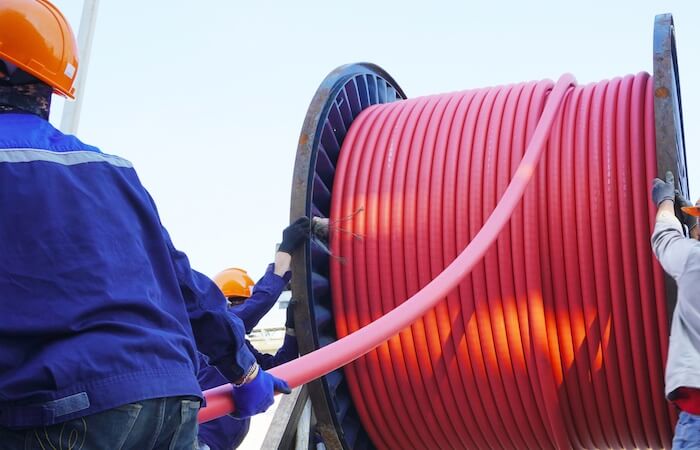6 Tools for Pulling Wire

In the bundled cable industry, we come across a lot of different products for pulling wire through conduit. Here are some that have caught our attention.
1) CP1000
The CP1000 by Electrical Product Innovation is a cordless handheld wire puller that attaches to your portable power drill. It can pull wires up to 1/0 gauge in size, measures 24″ in length when fully extended, and collapses into a transportable size that fits in most tool bags. The CP1000 increases the efficiency of wire pulling jobs, but it’s also making a name for itself because of its effects on worker safety. Shoulder, wrist, and other repetitive-motion-injuries that are common amongst electrical contractors are minimized by using this tool. Job efficiency, portability, and improved safety make the CP1000 one of the best wire pulling tools available.
2) Fish Tape
Fish tape, also known as draw wire, draw tape, or an “electricians snake,” is a thin, long band of steel or fiberglass that’s coiled around a reel. It’s particularly popular for pulling 12 gauge wires or low voltage cable. Fiberglass offers more protection against accidental conductivity but sacrifices rigidity. Steel can be guided easier because it produces more tension and rigidity before bending. In addition to choosing the right fish tape material, the construction and quality of the reel the fish tape is on is critical. Quality fish tape is useless if your reel binds or breaks mid-pull and you’re stuck with half a run of wiring hidden behind a wall.
3) Wire Pulling Rods
Also called “fish sticks,” wire pulling rods are shorter in length than fish tape, and they aren’t used along with a reel. While fish tape is great for running conduits long distances, rods are ideal for navigating shorter, tighter spaces. This makes rods ideal for electrical contractors running wire through a cramped area with little wiggle room, like inside a wall or ceiling. There are also glow rods that shine in the dark to enable you to see what you’re doing in these darker, smaller workspaces. Wire pulling rods also come with a variety of different heads to suit your needs, such as hooks, loops, and magnetic heads.
4) Nylon Pull Rope
Nylon pull rope, also called “pull string,” “pull lines,” or “pull cords,” has an excellent tensile-strength-to-weight ratio, and is classified by its pound pull weight capacity. Nylon pull rope is used for pulling wires and cables, usually in conjunction with other tools described here. When a rod or tape has a hook or looped end, the pull rope is fastened to it.
5) Conduit Piston with Vacuum
Also called a “conduit mouse,” conduit pistons are small cylinders, usually made of foam material. Wire is inserted into the conduit piston, which is then placed into the conduit. The piston gives the wire a larger end that’s easier to see, grab, and manipulate.
When the piston is inserted into the conduit, an industrial vacuum or shop vac is placed on the opposite end of the conduit. The tight fit of the piston in the conduit creates suction, and pulls the piston, rope, and wire all through the conduit. Electrical contractors often use pistons to run custom bundled cable configurations to save time on installation.
6) Bundled Cable
While all of these tools will help you run wires more efficiently, you’re still running each wire individually. Bundled cable manufacturers will create custom lengths, colors, and configurations of wires to match your exact project specifications. Custom marked and bundled cable saves electrical contractors an average of 30% in installation costs by enabling them to get the job done quickly with just a single pull. When you pull bundled cable using the tools described here, your wire pulling job will reach maximum efficiency.

READY TO SAVE TIME & MONEY WITH BUNDLED CABLE?
Get a quote on our custom cable bundles today.


